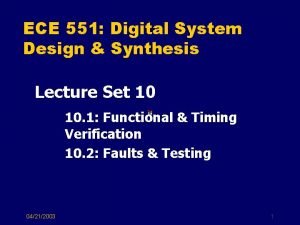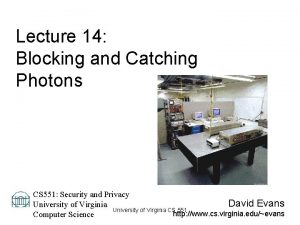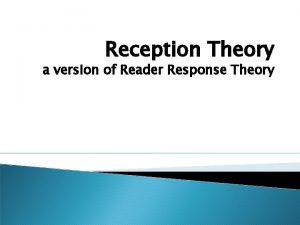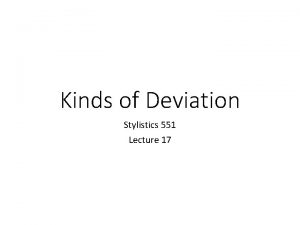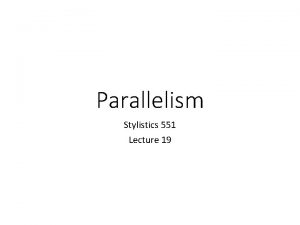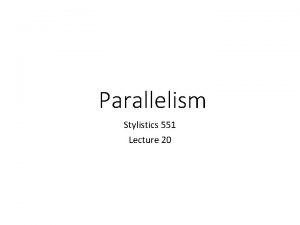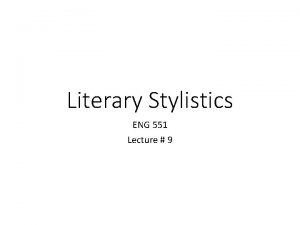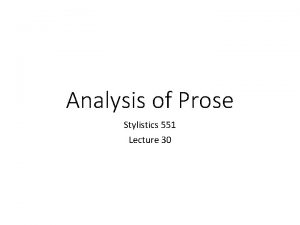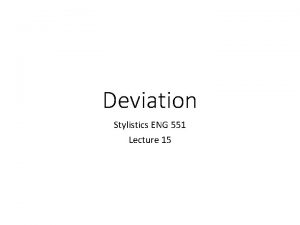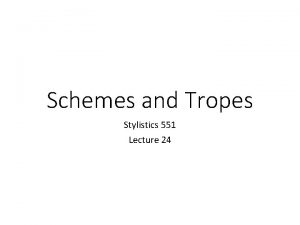Kinds of Parallelism Stylistics 551 Lecture 21 Parallelism















- Slides: 15

Kinds of Parallelism Stylistics 551 Lecture 21

Parallelism • Parallelism is the use of components in a sentence that are grammatically the same, or similar in their construction, sound, meaning or meter. Examples of parallelism are found in literary works as well as in ordinary speech. • Parallelism as a device adds balance and rhythm to sentences, giving ideas a smoother flow and thus can be persuasive because of the repetition it employs. • e. g. “Alice ran into the room, into the garden, and into our hearts”

Parallelism • This repetition of a phrase not only gives the sentence a balance but rhythm and flow as well. • This repetition can also occur in similar structured clauses e. g. “whenever you need me, wherever you need me, I will be there for you”

• Grammatical Parallelism: • The principal of parallel construction is a simple one. the reader expects consistency. Ideas that are related to each other (grammarians call these Coordinate clauses) should be expressed in parallel form. Expressions similar in content and function should be expressed similarly.

Example • Non-parallel construction: “She is capable, experienced and often works late at night” • Shift form series or adjectives: ‘capable’ ‘experienced’ to a verb phrase “often works late at night” • The result is the break of rhythm, there should be an adjective in place of the verb phrase like hardworking, dedicated, committed. • In parallelism the point is to be consistent. This gives writing rhythm, symmetry that creates emphasis.

“What the hammer? What the chain? In what furnace was thy brain? What the anvil? what dread grasp Dare its deadly terrors clasp? (William Blake, The Tyger)

Friends, Romans, Countrymen, lend me your ears; I come to bury Caesar, not to praise him” (Shakespeare, Julius Caesar) • The author uses parallel structure in both the lines. In the first line parallel structure equates three different groups of society: friends, Romans and countrymen. In the second line the author uses parallel structure with the phrases “to bury Caesar, not to praise him”

• 1. Synonymous Parallelism : • The very same thought is repeated, at times in the very same words. The following examples will illustrate parallelism. Common patterns of meaning sustained between these parallel lines. • Therefore the wicked will not stand in the judgment Nor sinners in the assembly of the righteous • Who may ascend the hill of the Lord? Who may stand in his holy place?

2. Antithetical Parallelism In it two opposite ideas are put together in parallel structure. The thought of the first line is expressed by and antithesis in the second, or is counterbalanced by a contrast in the second. • To err is human to forgive divine • The tongue of the wise adorneth knowledge, The mouth of the fool blurteth our folly

Antithetical Parallelism “Good we must love, and must hate ill For ill is ill, and good still; But there are things indifferent, Which we may neither hate, not love But one, and then another prove, As we shall find our fancy bent”

3. Synthetic Parallelism in it the second or third line of the unit are not synonymous or antithetic to the first line but advance thought in a variety of other ways. The theme is worked up by the building of thought upon similar thought. Mightier than the voices of many water, Mightier than the breakers of the ocean In the high place is thy Lord

• As a father has compassion on his children, • So the Lord has compassion on those who fear him

4. Introverted Parallelism The thought veers from the main theme and then returns: Only in god be still my soul Only is god be still my soul From Him is my life From him is my life Only He is my rock, my salvation, Only he is my rock, my salvation My Fortress. I totter not. My fortress, I totter not How long will ye set upon a man Will ye dash upon him, all of you Only to thrust me form my height they pan

5. Stair-like Parallelism The thought is repeated, in pretty much the same words and is developed still further. Lord shall guard thee from all evil, Lord shall guard thy soul Lord shall guard thy coming and thy going From now for ever more.

6. Emblematic parallelism: • The building up of thought by use of simile Jahweh, my god, early I seek Thee My soul doth faim for Thee My flesh doth faint for Thee Like a land of drought it thirst for Thee.
 Instruction level parallelism vs thread level parallelism
Instruction level parallelism vs thread level parallelism 01:640:244 lecture notes - lecture 15: plat, idah, farad
01:640:244 lecture notes - lecture 15: plat, idah, farad Number 551
Number 551 Ece 551
Ece 551 Csci-b 551 elements of artificial intelligence
Csci-b 551 elements of artificial intelligence Cs 551
Cs 551 450 yüzlüğe yuvarlama
450 yüzlüğe yuvarlama Cs 551
Cs 551 O homem que calculava malba tahan
O homem que calculava malba tahan Akpc 551 manual
Akpc 551 manual Ece 551
Ece 551 Eu avisto uma terra feliz numero
Eu avisto uma terra feliz numero I 551 number
I 551 number Reader's response theory
Reader's response theory Graphon stylistics
Graphon stylistics Purpose of stylistics
Purpose of stylistics



